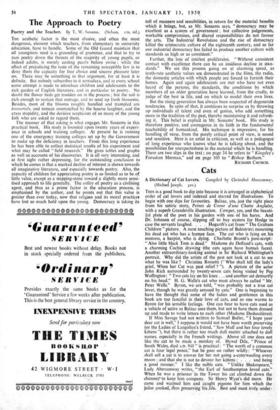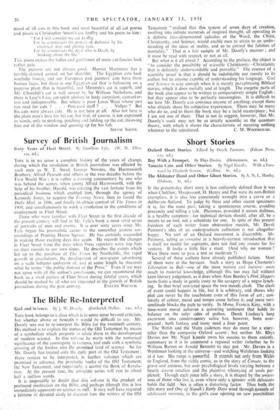Cats
THIS is a good book to dip into because it is arranged in alphabetical order of cat lovers and indexed and starred for illustrations. To begin with one dips for favourites. Balzac, yes, just the right piece from his satiric story, Peines de Coeur dune Chatte Anglaise, with a superb Grandeville illustration. Cowper, yes, and the beauti- ful plate of the poet in his garden with one of his hares. And Dr. Johnson of course, slipping off to buy oysters for Hodge -in case the servants laughed. . . . Hogarth's cat from "The Graham Children " picture. A most touching picture of Balestrieri mourning his dead cat who has a human face. The cat who is lying on his mistress, a harpist, who is dying. Charlotte Bronte's post-script: "Also little black Tom is dead." Madame du Deffand's cats, with a charming Cochin drawing (the cats again have human faces). Another extraordinary-looking animal in Sir Richard VVhittington's portrait. Why did the artists of the past not look at a cat to see what he was like ? Christina Rossetti (" Who shall tell the lady's grief, When her Cat was past relief ? "). A picture of the actor John Rich surrounded by twenty-seven cats being visited by Peg Woffington: "Two cats lay on his knee. .. and another sat demurely on his head." H. G. Wells's cat who must always be called "Mr. Peter Wells." Byron, we,are told, " was probably not a true cat lover, though he was greatly amused by cats." One is beginning to have the thought that some of the ladies and gentlemen in this book are too fanciful in their love of cats, and so one warms to Byron for his sensible feelings. One can bear to have cats used as a vehicle of satire as Balzac uses them, but not to have them dressed up and made to write letters-to each other (Madame Deshouli6res).
If Miss Savage had not written to Samuel Butler, "I hope your dear cat is well," I suppose it would not have been worth preserving (or the Ladies of Langollen's friend, "Saw Muff and her four lovely. kittens "), but there is rather too much dull matter attached to dull names, especially in the French writings. Above all one does not like the cat to be made a monkey of. Hywel Dda, "Prince of South Wales, died A.D. 948" is practical: "The worth of a common cat is four legal pence," but he goes on rather wildly: "Whoever .shall sell a cat is to answer for her not going a-caterwauling every moon • and that she is not to devour her kittens . . . and being a good mouser." I like the noble cats. "Unlike Shakespeare," Lady Aberconway writes,, "the Earl of Southampton loved cats." When he was a prisoner' in the Tower his cat climbed down the chimney' to keep him company. Sir Henry Wyat's did more. He came and warmed him and caught pigeons for him which the jailor cooked, thus preserving his Jife. Best and most-truly under-
stood of all cats in this book and most beautiful of all cat poems and pieces is Christopher Smart's cat Jeoffry and his poem to him: For 1 will consider my cat Jeoffry For he counteracts the powers of darkness by his electrical skin and glaring eyes.
For he counteracts the devil who is Death, by
brisking about the life.- This poem makes the ladies and gentlemen of mere cat-fancies look rather pale.
The pictures are not always good. Harriet Martineau has a terrible-skinned animal on her shoulder. The Egyptian cats look woefully frozen, and our European past painters' cats have these human faces, but there is one Egyptian cat that is balancing on a papyrus plant that is beautiful, and Merimee's cat is superb, and Mr. Churchill's cat is well served by Sir William Nicholson, and there is Lear's Foss, cat-spirit abolute in body corpulent, cantanker- ous and indispensable. But where is poor Louis Wain whose pen ran mad for cats ? . . Post-card stuff ? . . . Vulgar ? But his cats were always cats. He is not here at all. Also not here is the plain man's love for his cat, but that, of course, is not expressed in words, only in stroking, pinching and folding up the cat, throwing him out of the window and queuing up for his fish.
STEVIE SMITH.































 Previous page
Previous page